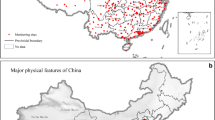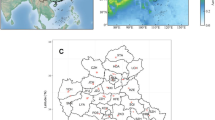Abstract
In order to provide scientific support to policy makers in the regulation of PM2.5 pollution in China, it is important to accurately assess the current status, spatiotemporal characteristics and regionalization data for this air pollutant. An analysis of the pollution status of PM2.5 was conducted using daily averaged mass concentration data recorded in 74 cities in 2013 and 161 cities in 2014. The rotated empirical orthogonal function (REOF) method was applied to analyze this data. Results showed that the average annual PM2.5 concentration in urban areas of China is 62.2±21.5 µg/m3, and that the distribution is spatially heterogeneous. The North China Plain, middle and lower Yangtze River Plain, Si Chuan Basin and Guanzhong Plain had relatively high annual PM2.5 concentrations compared with the southeast coastal region, the Tibetan Plateau and the Yungui Plateau. PM2.5 mass concentrations tended to be higher in winter than in summer, however, the data for many cities showed a small peak in concentrations from May to July. An analysis of the spatial correlation of PM2.5 indicated a significant influence of topographic conditions. A lower correlation was observed where terrain features varied greatly. Based on the results of the REOF analysis and topographic characteristics, ten regions were identified in mid-eastern China, which could be considered as basic pollution prevention divisions for PM2.5; these include the North China Plain region, Pearl River Delta region, Jianghuai Plain region, middle Yangtze River Plain region, Northeast Plain region, Jiangnan coastal region, Si chuan Basin region, Qiantao Plain region, Guanzhong-Central Plain region and Yungui Plateau region. Seasonal variations in the regionalization data were observed, especially for the North China Plain and Pearl River Delta regions. Among the ten regions identified in this study, the North China Plain, Guanzhong-Central Plain, middle Yangtze River Plain and Jianghuai Plain had relatively high PM2.5 mass concentrations in comparison with the others. Therefore, these regions should be considered as the key regions to target in developing PM2.5 pollution prevention strategies. This study improves the present understanding of the spatial distribution, seasonal changes and regional status of PM2.5 pollution in China and helps establish possible control strategies for the reduction of this air pollutant.
Similar content being viewed by others
References
Wang YS, Yao L, Wang LL, Liu ZR, Ji DS, Tang GQ, Zhang JK, Sun Y, Hu B, Xin JY. Mechanism for the formation of the January 2013 heavy haze pollution episode over central and eastern China. Sci China Earth Sci, 2014; 57: 14–25
Chan CK, Yao X. Air pollution in mega cities in China. Atmos Environ, 2008; 42: 1–42
Pope CA, Thun MJ, Namboodiri MM, Dockery DW, Evans JS, Speizer FE, Health CWJ. Particulate air pollution as a predictor of mortality in a prospective study of U.S. adults. Am J Respir Crit Care Med, 1995; 151: 669–674
Ito K, Mathes R, Ross Z, Nadas A, Thurston G, Matte T. Fine particulate matter constituents associated with cardiovascular hospitalizations and mortality in New York city. Environ Health Persp, 2011; 119: 467–473
Cao J, Xu H, Xu Q, Chen B, Kan H. Fine particulate matter constituents and cardiopulmonary mortality in a heavily polluted Chinese city. Environ Health Persp, 2012; 120: 373–378
Pope CA, Burnett RT, Thun MJ, Calle EE, Krewski D, Ito K, Thurston GD. Lung cancer, cardiopulmonary mortality, and long-term exposure to fine particulate air pollution. J Am Med Assoc., 2002, 287: 1132–1141
Zhang XY, Wang YQ, Niu T, Zhang XC, Gong SL, Zhang YM, Sun JY. Atmospheric aerosol compositions in China: spatial/temporal variability, chemical signature, regional haze distribution and comparisons with global aerosols. Atmos Chem Phy, 2012, 12: 779–799
Malm WC, Schichtel BA, Pitchford ML, Ashbaugh LL, Eldred RA. Spatial and monthly trends in speciated fine particle concentration in the United States. J Geophys Res Atmos, 2004, 109, D03306
Malm WC, Sisler JF, Huffman D, Eldred RA, Cahill TA. Spatial and seasonal trends in particle concentration and optical extinction in the U.S. J Geophys Res, 1994; 99: 1347–1370
Querol X, Alastuey A, Moreno T, Viana MM, Castillo S, Pey J, Rodriguez S, Artinano B, Salvador P, Sanchez M, Garcia Dos Santos S, Herce Garraleta MD, Fernandez-Patier R, Moreno-Grau S, Negral L, Minguillon MC, Monfort E, Sanz MJ, Palomo-Marin R, Pinilla-Gil E, Cuevas E, de la Rosa J, Sanchez de la Campa A. Spatial and temporal variations in airborne particulate matter (PM10 and PM2.5) across Spain 1999–2005. Atmos Environ, 2008; 42: 3964–3979
Querol X, Alastuey A, Ruiz CR, Artinano B, Hansson HC, Harrison RM, Buringh E, ten Brink HM, Lutz M, Bruckmann P, Straehl P, Schneider J. Speciation and origin of PM10 and PM2.5 in selected European cities. Atmos Environ, 2004, 38, 6547–6555
Li R, Li Z, Gao W, Ding W, Xu Q, Song X. Diurnal, seasonal, and spatial variation of PM2.5 in Beijing. Sci Bull, 2015; 60: 387–395
Deng T, Wu D, Deng X J, Tan HB, Li F, Liao BT. A vertical sounding of severe haze process in Guangzhou area. Sci China Earth Sci, 2014; 57: 2650–2656
Zhao M, Huang Z, Qiao T, Zhang Y, Xiu G, Yu J. Chemical characterization, the transport pathways and potential sources of PM2.5 in Shanghai: seasonal variations. Atmos Res, 2015, 158–159: 66–78
Han L, Zhou W, Li W, Li L. Impact of urbanization level on urban air quality: a case of fine particles (PM2.5) in Chinese cities. Environ Pollut, 2014; 194: 163–170
Xin J, Zhang Q, Wang L, Gong C, Wang Y, Liu Z, Gao W. The empirical relationship between the PM2.5 concentration and aerosol optical depth over the background of North China from 2009 to 2011. Atmos Res, 2014; 138: 179–188
Tao J, Zhang L, Engling G, Zhang R, Yang Y, Cao J, Zhu C, Wang Q, Luo L. Chemical composition of PM2.5 in an urban environment in Chengdu, China: importance of springtime dust storms and biomass burning. Atmos Res, 2013; 122: 270–283
Xue W, Fu F, Wang J, Tang G, Lei Y, Yang J, Wang Y. Numerical study on the characteristics of regional transport of PM2.5 in China. China Environmental Science, 2014; 34: 1361–1368
Duan Y, Wei H, Fu Q, Gao S, Huang R, Huang Y. Regional spatio- temporal mode differences of air pollution index of key environmental protection cities in China. Acta Scientiae Circumstantiae, 2008, 28: 384–391
Chen Y, Chen N, Wang S, Qian Z, Mu J. Temporal and spatial change features of precipitation over China-Mongolia arid- and semiarid- areas(I): annual rainfall feature and May–September one REOF analysis. Plateau Meteorology, 2010; 29: 33–43
Chen Y, Chen N, Qian Z, Wang S. Temporal and spatial change features of precipitation over CMASA (II): synthetical climate subregions of the CMASA and further analyses of periodic change of precipitation in its various ones. Plateau Meteorology, 2011; 30: 13–21
Yang S, Xu L. Linkage between Eurasian winter snow cover and regional Chinese summer rainfall. Int J Climatol, 1994; 14: 739–750
Richard AJ, Dean WW. Applied Multivariate Statistical Analysis Lu X, Trans. 4th ed. Beijing: Tsinghua University Press, 2001. 388–414
Sharma P, Sharma P, Jain S, Kumar P. An integrated statistical approach for evaluating the exceedence of criteria pollutants in the ambient air of megacity Delhi. Atmos Environ, 2013; 70: 7–17
Kan HD, Chen BH. Statistical distributions of ambient air pollutants in Shanghai, China. Biomed Environ Sci, 2004; 17: 366–372
van Donkelaar A, Martin RV, Brauer M, Kahn R, Levy R, Verduzco C, Villeneuve PJ. Global estimates of ambient fine particulate matter concentrations from satellite-based aerosol optical depth: development and application. Environ Health Persp, 2010; 118: 847–855
Guo L, Zhang Y, Liu S, Li J, Ma Y. Correlation analysis between PM10 mass concentration and meteorological elements of atmospheric boundary layer in Beijing area. Acta Sci Nat Univ Pek, 2011, 47: 607–612
Xu XD, Wang YJ, Zhao TL, Cheng XH, Meng YY, Ding GA. “Harbor” effect of large topography on haze distribution in eastern China and its climate modulation on decadal variations in haze. Chin Sci Bull, 2015, 60: 1132–1143
Hand JL, Schichtel BA, Malm WC, Pitchford M, Frank NH. Spatial and seasonal patterns in urban influence on regional concentrations of speciated aerosols across the United States. J Geophys Res Atmos, 2014, 119: 12832–12849
Cao G, An X, Zhou C, Ren Y, Tu J. Emission inventory of air pollutants in China. China Environmental Science, 2010; 30: 900–906
He L, Wang W, Wang Q, Wei B, Li Q, Wang C, Liu X. Evaluation of the agriculture residues burning reduction in China using MODIS fire product. Environmental Monitoring in China, 2007; 23: 42–50
Li Q, Zhang L, Wu C, Sun Z, Liu X. Satellite remote sensing based monitoring of straw burning and analysis of its impact on air quality. Journal of Ecology and Rural Environment, 2009; 25: 32–37
Li J, Song Y, Mao Y, Mao Z, Wu Y, Li M, Huang X, He Q, Hu M. Chemical characteristics and source apportionment of PM2.5 during the harvest season in eastern China’s agricultural regions. Atmos Environ, 2014; 92: 442–448
Bouwman AF, Lee DS, Asman WAH, Dentener FJ, van der Hoek KW, Olivier JGJ. A global high-resolution emission inventory for ammonia. Global Biogeochem Cy, 1997, 11: 561–587
Shen J, Liu X, Zhang Y, Fangmeier A, Goulding K, Zhang F. Atmospheric ammonia and particulate ammonium from agricultural sources in the North China Plain. Atmos Environ, 2011; 45: 5033–5041
Xiao Q, Wu R. Numerical experiments of influence of topography on atmospheric motion. Acta Meteorologica Sinica, 1995; 53: 38–49
Sharman RD, Wurtele MG. Three-dimensional structure of forced gravity waves and lee waves. J Atmos Sci, 2004; 61: 664–681
Zhao Y, Xu X, Cui C. Case study of the impact of mesoscale topography on the Meiyu frontal rainstorm. Plateau Meteorology, 2012; 31: 1268–1282
Author information
Authors and Affiliations
Corresponding author
Rights and permissions
About this article
Cite this article
Wang, S., Li, G., Gong, Z. et al. Spatial distribution, seasonal variation and regionalization of PM2.5 concentrations in China. Sci. China Chem. 58, 1435–1443 (2015). https://doi.org/10.1007/s11426-015-5468-9
Received:
Accepted:
Published:
Issue Date:
DOI: https://doi.org/10.1007/s11426-015-5468-9




